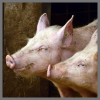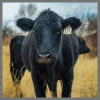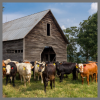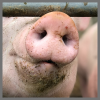-

Sep
21
Interpretive Summary: Diet production and utilization of corn fermented protein compared to traditional yeast in healthy adult cats

The inclusion of yeast in pet food can provide health benefits and increase palatability. Corn-fermented protein is a co-product from ethanol production which contains approximately 20% to 25% yeast.
Read more
-

Sep
21
Interpretive Summary: Standardized amino acid digestibility and protein quality in extruded canine diets containing hydrolyzed protein using a precision-fed rooster assay

Hydrolyzed protein has been more commonly used in the pet food industry recently to increase digestibility, decrease allergenic responses, and for other health benefits (such as anti-inflammation and anti-oxidation) in companion animals. The study was designed to determine the protein quality of two protein hydrolysates for incorporating into dry dog foods.
Read more
-

Sep
14
Interpretive Summary: The impact of protein source and grain inclusion on digestibility, fecal metabolites, and fecal microbiome in adult canines

A recent topic of debate in pet food is whether grain or pulse ingredients and varying amounts of animal-based protein compared to plant proteins are better for pets’ health. Thus, the need to examine ingredients used in pet food is important.
Read more
-

Sep
14
Interpretive Summary: Short-term changes in dietary fat levels and starch sources affect weight management, glucose and lipid metabolism, and gut microbiota in adult cats

Obesity is a common problem in domestic cats. Fat in dry-extruded pet food may be a risk factor for feline obesity. Additionally, the utilization of various carbohydrates in domestic cats has garnered attention. This study explored the impact of varying fat levels and starch sources on body weight, glucose metabolism, and gut microbiota composition in healthy adult cats.
Read more
-

Sep
14
Interpretive Summary: Boundaries for genotype, phenotype, and pedigree truncation in genomic evaluations in pigs

Recording data for long years is common in animal breeding and genetics. However, the larger the data, the higher the computing cost of the analysis, especially with genomic information. This study aimed to investigate the impact of removing data, namely, genotypes, phenotypes, and pedigree, on the computing performance and prediction ability of genomic breeding values.
Read more
-

Sep
14
Interpretive Summary: Variance component estimates for growth traits in beef cattle using selected variants from imputed low-pass sequence data

Animals from a crossbred beef cattle population were sequenced at low depth (i.e., 0.5×) and different subsets of selected imputed variants were investigated relative to their ability to explain variation in birth weight (BWT) and post-weaning gain (PWG).
Read more
-

Sep
14
Interpretive Summary: High-grain diet feeding alters ileal microbiota and disrupts bile acid metabolism in lactating dairy cows

Bile acids plays an important role in regulating lipids metabolism in animals and human. Dairy cows fed high-grain (HG) diet generally suffer abnormal lipids metabolism. However, if there is a relationship between the bile acids metabolism and abnormal lipids metabolism in dairy cows fed HG diet is unclear.
Read more
-

Sep
14
Infographic: In vitro gametogenesis from embryonic stem cells in livestock species: recent advances, opportunities, and challenges to overcome

In vitro gametogenesis (IVG) is the ability to mimic the reproductive cycle in a dish and presents a paradigm shift for producing viable gametes and healthy offspring in animal agriculture.
Read more
-

Sep
07
Interpretive Summary: The real place of livestock in GHG emissions and their control for climate change

Climate change presents multiple challenges to the livestock industry including the need to examine animal and environmental management practices to enhance efficiency, reduce greenhouse gas emissions from animals and manure, reduce water and other resource use, and pressure to eliminate meat and livestock products from diets.
Read more
-

Sep
07
Interpretive Summary: Metagenome strain deconvolution and abundance estimation enabled by low-error long-read DNA sequence

The rumen microbiome is essential to animal nutrition and health, but current genetics resources to study this community are incomplete.
Read more
-

Sep
07
Interpretive Summary: Update of nutritional requirements of goats for growth and pregnancy in hot environments

Goats serve as a valuable source of income in agriculture, supplying both milk and meat. Their adaptability to diverse environments makes them a viable choice among rural households for livestock, especially in harsh environments. Research has been dedicated to refining goat feeding systems and determining their nutritional requirements.
Read more
-

Sep
07
Interpretive Summary: Livestock-wildlife conflicts: A struggle for land use and conservation in the U.S. Mountain West

Livestock production in the Intermountain West of the United States (U.S.) largely depends on grazing access to U.S. government-owned “public lands”, which also provide habitat for many of North American’s iconic wildlife species.
Read more
-

Sep
07
Interpretive Summary: Genetic selection for dairy calf disease resistance traits: opportunities and challenges

Genetic selection is a viable option to help improve calf health. Producer recorded calf disease data comprised of 69,695 Holstein calf disease records for respiratory problems (RESP) and diarrhea (DIAR). Across analyses, heritability estimates for RESP and DIAR ranged from 0.02 to 0.07, indicating the potential for selection.
Read more
-

Aug
31
Interpretive Summary: Dairy groups comment on the FDA’s draft guidelines for plant milk-alternative labeling

The National Milk Producers Federation (NMPF) and the International Dairy Foods Association (IDFA) have submitted public comments on the United States Food and Drug Administration’s (FDA’s) draft guidance for plant milk-alternative labeling.
Read more
-

Aug
31
Interpretive Summary: FDA request input on antimicrobial use in animals

The United States Food and Drug Administration (FDA) is seeking public comments on a new report, which discusses a potential framework for establishing a public-private partnership (PPP) to collect and analyze antimicrobial use (AMU) data from food-producing animals. The report was created for the FDA by the Reagan-Udall Foundation (the Foundation) and summarizes the work completed over a multi-year cooperative agreement funded by the FDA.
Read more
-

Aug
31
Interpretive Summary: Lawsuit filed against Massachusetts’ Question 3

A group of pork producers have filed a lawsuit in Massachusetts against the Act to Prevent Cruelty to Farm Animals (Question 3). Passed by voters in November 2016, Question 3 imposes confinement requirements on out-of-state pork producers and prohibits the sale of pork meat within the state from offspring of an animal confined in a manner inconsistent with Massachusetts' requirements, regardless of where in the nation the animal was raised.
Read more
-

Aug
31
Interpretive Summary: New bill proposes senior nutrition taskforce

A new bipartisan bill has been introduced to improve nutrition in older adults. The Senior Nutrition Taskforce Act of 2023 would establish an interagency taskforce to address hunger and help seniors, as well as adults with disabilities, better access healthy foods.
Read more
-

Aug
31
Interpretive Summary: Preserving Family Farms Act reintroduced

United States Representatives Jimmy Panetta (D-CA) and Mike Kelly (R-PA) have reintroduced the Preserving Family Farms Act of 2023. The bill would modify tax law, allowing farmers and ranchers to pay estate taxes based on the value of their land for agricultural use.
Read more
-

Aug
31
Interpretive Summary: Some of the Endangered Species Act’s listings will soon be modified

Two resolutions to nullify the Biden Administration’s Endangered Species Act listings have passed the Senate and the House of Representatives and will now go to the President’s desk for signature. The two listings would nullify the lesser prairie chicken listing and the northern long-eared bat listing. Matters of the Endangered Species Act are typically left to the United States Fish and Wildlife Service and the National Marine Fisheries Service, to decide which animals and plants to list as endangered or threatened and how to rebuild their populations.
Read more
-

Aug
31
Interpretive Summary: The Farmland Security Act of 2023 is introduced

United States Senators Tammy Baldwin (D-WI) and Chuck Grassley (R-IA) introduced a new bill, designed to increase the transparency and oversight of foreign ownership in America’s agricultural industry. The Farmland Security Act of 2023 builds on the Farmland Security Act of 2022, by ensuring that all foreign investors who buy American agricultural land report their holdings and strengthens the penalties for those who evade the required filing.
Read more
 SepInterpretive Summary: Diet production and utilization of corn fermented protein compared to traditional yeast in healthy adult cats
SepInterpretive Summary: Diet production and utilization of corn fermented protein compared to traditional yeast in healthy adult cats The inclusion of yeast in pet food can provide health benefits and increase palatability. Corn-fermented protein is a co-product from ethanol production which contains approximately 20% to 25% yeast.
The inclusion of yeast in pet food can provide health benefits and increase palatability. Corn-fermented protein is a co-product from ethanol production which contains approximately 20% to 25% yeast. SepInterpretive Summary: Standardized amino acid digestibility and protein quality in extruded canine diets containing hydrolyzed protein using a precision-fed rooster assay
SepInterpretive Summary: Standardized amino acid digestibility and protein quality in extruded canine diets containing hydrolyzed protein using a precision-fed rooster assay Hydrolyzed protein has been more commonly used in the pet food industry recently to increase digestibility, decrease allergenic responses, and for other health benefits (such as anti-inflammation and anti-oxidation) in companion animals. The study was designed to determine the protein quality of two protein hydrolysates for incorporating into dry dog foods.
Hydrolyzed protein has been more commonly used in the pet food industry recently to increase digestibility, decrease allergenic responses, and for other health benefits (such as anti-inflammation and anti-oxidation) in companion animals. The study was designed to determine the protein quality of two protein hydrolysates for incorporating into dry dog foods. SepInterpretive Summary: The impact of protein source and grain inclusion on digestibility, fecal metabolites, and fecal microbiome in adult canines
SepInterpretive Summary: The impact of protein source and grain inclusion on digestibility, fecal metabolites, and fecal microbiome in adult canines A recent topic of debate in pet food is whether grain or pulse ingredients and varying amounts of animal-based protein compared to plant proteins are better for pets’ health. Thus, the need to examine ingredients used in pet food is important.
A recent topic of debate in pet food is whether grain or pulse ingredients and varying amounts of animal-based protein compared to plant proteins are better for pets’ health. Thus, the need to examine ingredients used in pet food is important. SepInterpretive Summary: Short-term changes in dietary fat levels and starch sources affect weight management, glucose and lipid metabolism, and gut microbiota in adult cats
SepInterpretive Summary: Short-term changes in dietary fat levels and starch sources affect weight management, glucose and lipid metabolism, and gut microbiota in adult cats Obesity is a common problem in domestic cats. Fat in dry-extruded pet food may be a risk factor for feline obesity. Additionally, the utilization of various carbohydrates in domestic cats has garnered attention. This study explored the impact of varying fat levels and starch sources on body weight, glucose metabolism, and gut microbiota composition in healthy adult cats.
Obesity is a common problem in domestic cats. Fat in dry-extruded pet food may be a risk factor for feline obesity. Additionally, the utilization of various carbohydrates in domestic cats has garnered attention. This study explored the impact of varying fat levels and starch sources on body weight, glucose metabolism, and gut microbiota composition in healthy adult cats. SepInterpretive Summary: Boundaries for genotype, phenotype, and pedigree truncation in genomic evaluations in pigs
SepInterpretive Summary: Boundaries for genotype, phenotype, and pedigree truncation in genomic evaluations in pigs Recording data for long years is common in animal breeding and genetics. However, the larger the data, the higher the computing cost of the analysis, especially with genomic information. This study aimed to investigate the impact of removing data, namely, genotypes, phenotypes, and pedigree, on the computing performance and prediction ability of genomic breeding values.
Recording data for long years is common in animal breeding and genetics. However, the larger the data, the higher the computing cost of the analysis, especially with genomic information. This study aimed to investigate the impact of removing data, namely, genotypes, phenotypes, and pedigree, on the computing performance and prediction ability of genomic breeding values. SepInterpretive Summary: Variance component estimates for growth traits in beef cattle using selected variants from imputed low-pass sequence data
SepInterpretive Summary: Variance component estimates for growth traits in beef cattle using selected variants from imputed low-pass sequence data Animals from a crossbred beef cattle population were sequenced at low depth (i.e., 0.5×) and different subsets of selected imputed variants were investigated relative to their ability to explain variation in birth weight (BWT) and post-weaning gain (PWG).
Animals from a crossbred beef cattle population were sequenced at low depth (i.e., 0.5×) and different subsets of selected imputed variants were investigated relative to their ability to explain variation in birth weight (BWT) and post-weaning gain (PWG). SepInterpretive Summary: High-grain diet feeding alters ileal microbiota and disrupts bile acid metabolism in lactating dairy cows
SepInterpretive Summary: High-grain diet feeding alters ileal microbiota and disrupts bile acid metabolism in lactating dairy cows Bile acids plays an important role in regulating lipids metabolism in animals and human. Dairy cows fed high-grain (HG) diet generally suffer abnormal lipids metabolism. However, if there is a relationship between the bile acids metabolism and abnormal lipids metabolism in dairy cows fed HG diet is unclear.
Bile acids plays an important role in regulating lipids metabolism in animals and human. Dairy cows fed high-grain (HG) diet generally suffer abnormal lipids metabolism. However, if there is a relationship between the bile acids metabolism and abnormal lipids metabolism in dairy cows fed HG diet is unclear. SepInfographic: In vitro gametogenesis from embryonic stem cells in livestock species: recent advances, opportunities, and challenges to overcome
SepInfographic: In vitro gametogenesis from embryonic stem cells in livestock species: recent advances, opportunities, and challenges to overcome In vitro gametogenesis (IVG) is the ability to mimic the reproductive cycle in a dish and presents a paradigm shift for producing viable gametes and healthy offspring in animal agriculture.
In vitro gametogenesis (IVG) is the ability to mimic the reproductive cycle in a dish and presents a paradigm shift for producing viable gametes and healthy offspring in animal agriculture. SepInterpretive Summary: The real place of livestock in GHG emissions and their control for climate change
SepInterpretive Summary: The real place of livestock in GHG emissions and their control for climate change Climate change presents multiple challenges to the livestock industry including the need to examine animal and environmental management practices to enhance efficiency, reduce greenhouse gas emissions from animals and manure, reduce water and other resource use, and pressure to eliminate meat and livestock products from diets.
Climate change presents multiple challenges to the livestock industry including the need to examine animal and environmental management practices to enhance efficiency, reduce greenhouse gas emissions from animals and manure, reduce water and other resource use, and pressure to eliminate meat and livestock products from diets. SepInterpretive Summary: Metagenome strain deconvolution and abundance estimation enabled by low-error long-read DNA sequence
SepInterpretive Summary: Metagenome strain deconvolution and abundance estimation enabled by low-error long-read DNA sequence The rumen microbiome is essential to animal nutrition and health, but current genetics resources to study this community are incomplete.
The rumen microbiome is essential to animal nutrition and health, but current genetics resources to study this community are incomplete. SepInterpretive Summary: Update of nutritional requirements of goats for growth and pregnancy in hot environments
SepInterpretive Summary: Update of nutritional requirements of goats for growth and pregnancy in hot environments Goats serve as a valuable source of income in agriculture, supplying both milk and meat. Their adaptability to diverse environments makes them a viable choice among rural households for livestock, especially in harsh environments. Research has been dedicated to refining goat feeding systems and determining their nutritional requirements.
Goats serve as a valuable source of income in agriculture, supplying both milk and meat. Their adaptability to diverse environments makes them a viable choice among rural households for livestock, especially in harsh environments. Research has been dedicated to refining goat feeding systems and determining their nutritional requirements. SepInterpretive Summary: Livestock-wildlife conflicts: A struggle for land use and conservation in the U.S. Mountain West
SepInterpretive Summary: Livestock-wildlife conflicts: A struggle for land use and conservation in the U.S. Mountain West Livestock production in the Intermountain West of the United States (U.S.) largely depends on grazing access to U.S. government-owned “public lands”, which also provide habitat for many of North American’s iconic wildlife species.
Livestock production in the Intermountain West of the United States (U.S.) largely depends on grazing access to U.S. government-owned “public lands”, which also provide habitat for many of North American’s iconic wildlife species. SepInterpretive Summary: Genetic selection for dairy calf disease resistance traits: opportunities and challenges
SepInterpretive Summary: Genetic selection for dairy calf disease resistance traits: opportunities and challenges Genetic selection is a viable option to help improve calf health. Producer recorded calf disease data comprised of 69,695 Holstein calf disease records for respiratory problems (RESP) and diarrhea (DIAR). Across analyses, heritability estimates for RESP and DIAR ranged from 0.02 to 0.07, indicating the potential for selection.
Genetic selection is a viable option to help improve calf health. Producer recorded calf disease data comprised of 69,695 Holstein calf disease records for respiratory problems (RESP) and diarrhea (DIAR). Across analyses, heritability estimates for RESP and DIAR ranged from 0.02 to 0.07, indicating the potential for selection. AugInterpretive Summary: Dairy groups comment on the FDA’s draft guidelines for plant milk-alternative labeling
AugInterpretive Summary: Dairy groups comment on the FDA’s draft guidelines for plant milk-alternative labeling The National Milk Producers Federation (NMPF) and the International Dairy Foods Association (IDFA) have submitted public comments on the United States Food and Drug Administration’s (FDA’s) draft guidance for plant milk-alternative labeling.
The National Milk Producers Federation (NMPF) and the International Dairy Foods Association (IDFA) have submitted public comments on the United States Food and Drug Administration’s (FDA’s) draft guidance for plant milk-alternative labeling. AugInterpretive Summary: FDA request input on antimicrobial use in animals
AugInterpretive Summary: FDA request input on antimicrobial use in animals The United States Food and Drug Administration (FDA) is seeking public comments on a new report, which discusses a potential framework for establishing a public-private partnership (PPP) to collect and analyze antimicrobial use (AMU) data from food-producing animals. The report was created for the FDA by the Reagan-Udall Foundation (the Foundation) and summarizes the work completed over a multi-year cooperative agreement funded by the FDA.
The United States Food and Drug Administration (FDA) is seeking public comments on a new report, which discusses a potential framework for establishing a public-private partnership (PPP) to collect and analyze antimicrobial use (AMU) data from food-producing animals. The report was created for the FDA by the Reagan-Udall Foundation (the Foundation) and summarizes the work completed over a multi-year cooperative agreement funded by the FDA. AugInterpretive Summary: Lawsuit filed against Massachusetts’ Question 3
AugInterpretive Summary: Lawsuit filed against Massachusetts’ Question 3 A group of pork producers have filed a lawsuit in Massachusetts against the Act to Prevent Cruelty to Farm Animals (Question 3). Passed by voters in November 2016, Question 3 imposes confinement requirements on out-of-state pork producers and prohibits the sale of pork meat within the state from offspring of an animal confined in a manner inconsistent with Massachusetts' requirements, regardless of where in the nation the animal was raised.
A group of pork producers have filed a lawsuit in Massachusetts against the Act to Prevent Cruelty to Farm Animals (Question 3). Passed by voters in November 2016, Question 3 imposes confinement requirements on out-of-state pork producers and prohibits the sale of pork meat within the state from offspring of an animal confined in a manner inconsistent with Massachusetts' requirements, regardless of where in the nation the animal was raised. AugInterpretive Summary: New bill proposes senior nutrition taskforce
AugInterpretive Summary: New bill proposes senior nutrition taskforce A new bipartisan bill has been introduced to improve nutrition in older adults. The Senior Nutrition Taskforce Act of 2023 would establish an interagency taskforce to address hunger and help seniors, as well as adults with disabilities, better access healthy foods.
A new bipartisan bill has been introduced to improve nutrition in older adults. The Senior Nutrition Taskforce Act of 2023 would establish an interagency taskforce to address hunger and help seniors, as well as adults with disabilities, better access healthy foods. AugInterpretive Summary: Preserving Family Farms Act reintroduced
AugInterpretive Summary: Preserving Family Farms Act reintroduced United States Representatives Jimmy Panetta (D-CA) and Mike Kelly (R-PA) have reintroduced the Preserving Family Farms Act of 2023. The bill would modify tax law, allowing farmers and ranchers to pay estate taxes based on the value of their land for agricultural use.
United States Representatives Jimmy Panetta (D-CA) and Mike Kelly (R-PA) have reintroduced the Preserving Family Farms Act of 2023. The bill would modify tax law, allowing farmers and ranchers to pay estate taxes based on the value of their land for agricultural use. AugInterpretive Summary: Some of the Endangered Species Act’s listings will soon be modified
AugInterpretive Summary: Some of the Endangered Species Act’s listings will soon be modified Two resolutions to nullify the Biden Administration’s Endangered Species Act listings have passed the Senate and the House of Representatives and will now go to the President’s desk for signature. The two listings would nullify the lesser prairie chicken listing and the northern long-eared bat listing. Matters of the Endangered Species Act are typically left to the United States Fish and Wildlife Service and the National Marine Fisheries Service, to decide which animals and plants to list as endangered or threatened and how to rebuild their populations.
Two resolutions to nullify the Biden Administration’s Endangered Species Act listings have passed the Senate and the House of Representatives and will now go to the President’s desk for signature. The two listings would nullify the lesser prairie chicken listing and the northern long-eared bat listing. Matters of the Endangered Species Act are typically left to the United States Fish and Wildlife Service and the National Marine Fisheries Service, to decide which animals and plants to list as endangered or threatened and how to rebuild their populations. AugInterpretive Summary: The Farmland Security Act of 2023 is introduced
AugInterpretive Summary: The Farmland Security Act of 2023 is introduced United States Senators Tammy Baldwin (D-WI) and Chuck Grassley (R-IA) introduced a new bill, designed to increase the transparency and oversight of foreign ownership in America’s agricultural industry. The Farmland Security Act of 2023 builds on the Farmland Security Act of 2022, by ensuring that all foreign investors who buy American agricultural land report their holdings and strengthens the penalties for those who evade the required filing.
United States Senators Tammy Baldwin (D-WI) and Chuck Grassley (R-IA) introduced a new bill, designed to increase the transparency and oversight of foreign ownership in America’s agricultural industry. The Farmland Security Act of 2023 builds on the Farmland Security Act of 2022, by ensuring that all foreign investors who buy American agricultural land report their holdings and strengthens the penalties for those who evade the required filing.



